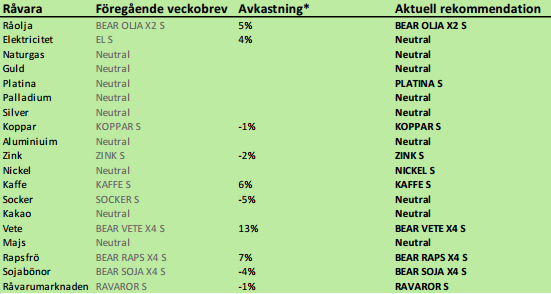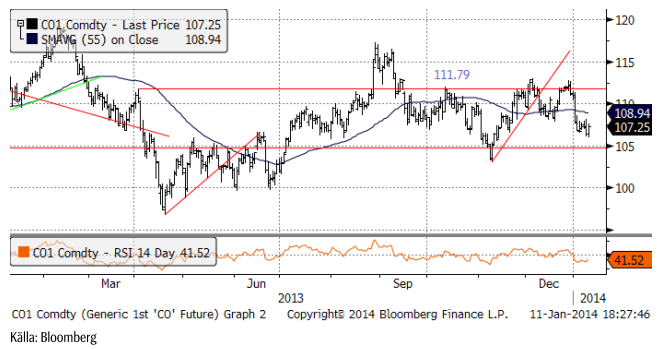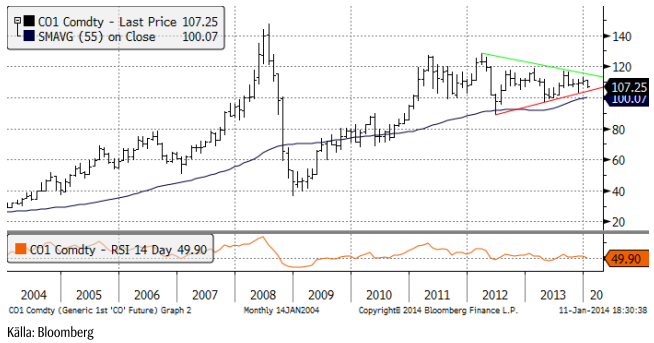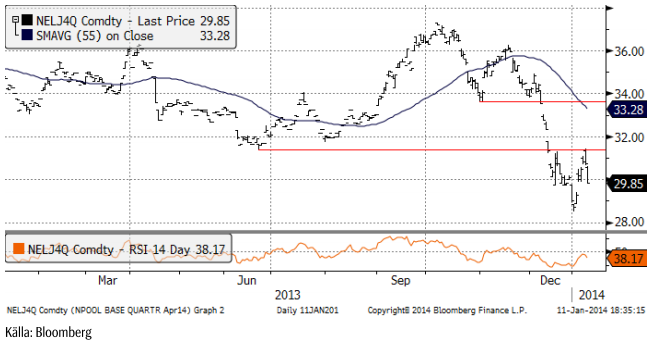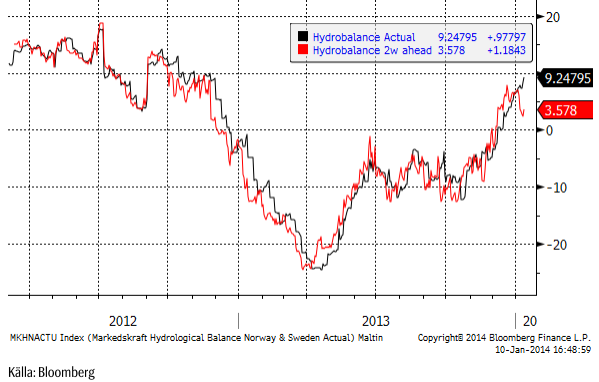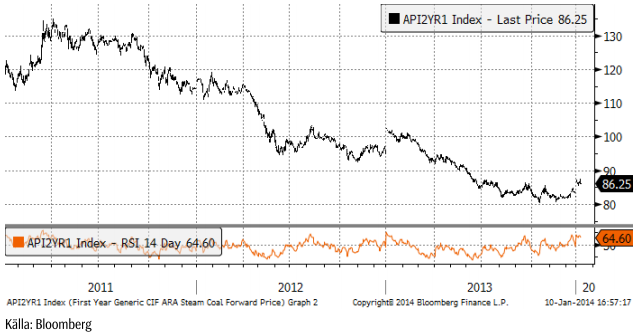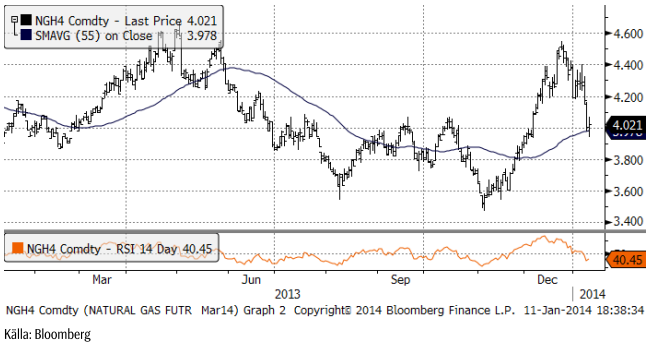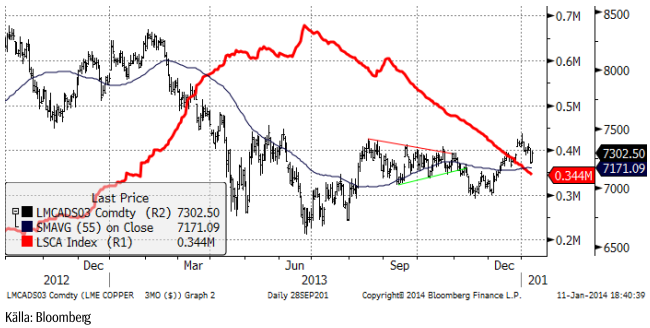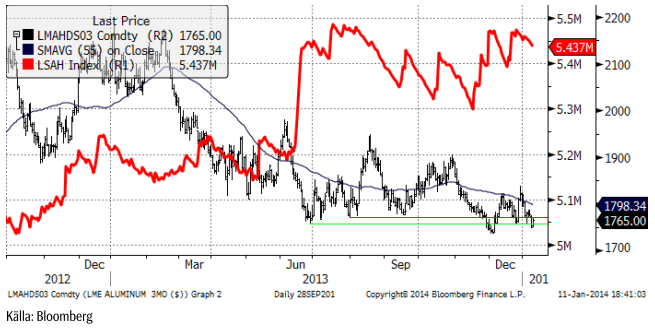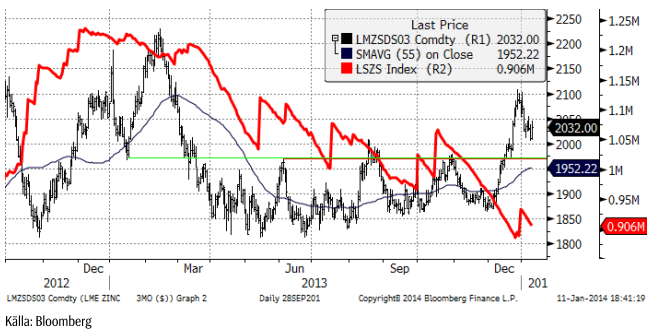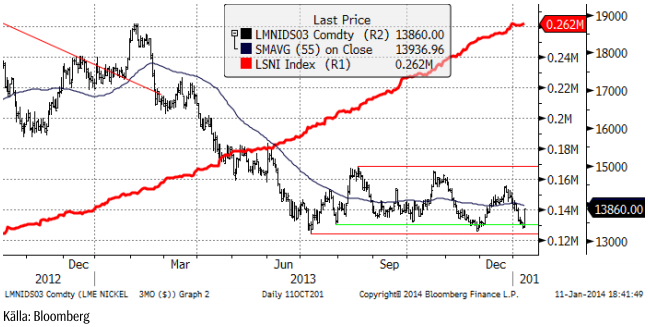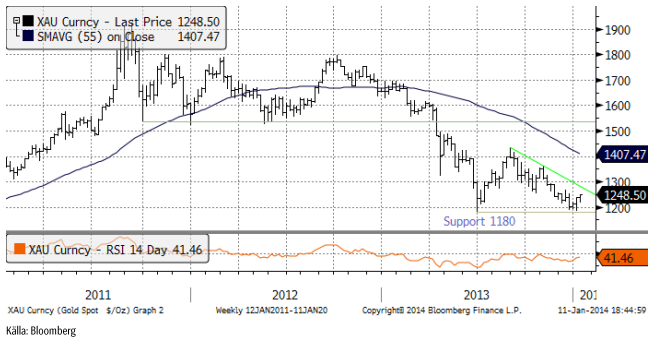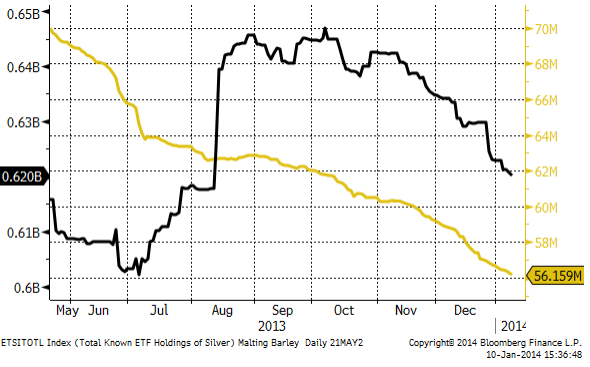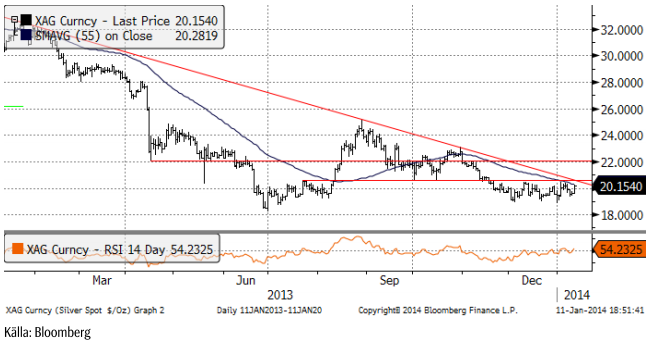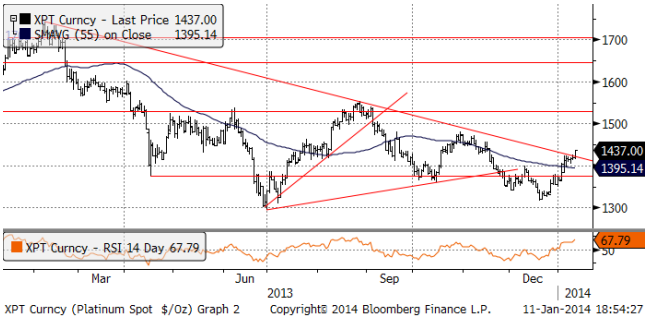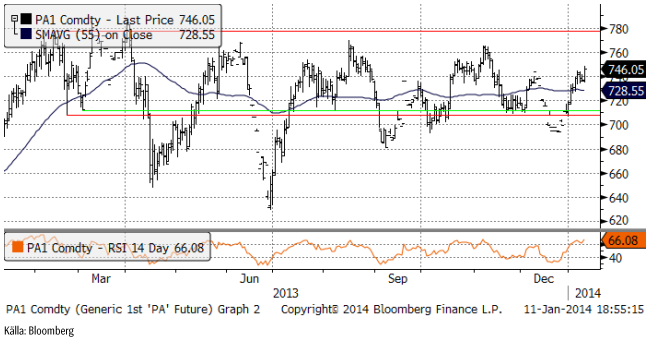Analys
SEB – Råvarukommentarer, 13 januari 2014

Rekommendationer
Inledning
Veckans vinnare blev MINIL KAFF B S med en uppgång på 46%, när kaffepriset steg förra veckan. Sedan Jul erbjuder vi även minifutures på råvaror. De är till för dem som vill ta extremt mycket risk. Risken är lika hög som i de riktiga terminerna, men i mindre storlek och tillgängliga över aktiebörsen.
Tre nyheter från förra veckan är viktiga för råvarumarknaden: I fredags publicerades antalet nyanställningar i USA kallad ”Non-Farm Payrolls”. Marknaden hade väntat sig 197,000 nyanställningar i december, men det blev bara 75,000. När FED just påbörjat nedtrappningen av takten i penningmängdsökningen den 18 december för att ekonomin i USA såg ut att klara sig, var NFP-siffran förvånande svag. Den fick en påverkan på dollarn, som föll och på guldet som steg. Den andra nyheten kom vid 18 i fredags från det amerikanska jordbruksdepartementet, årets första World Agricultural Supply and Demand Estimates (WASDE). Matif hann inte reagera fullt ut eftersom rapporten kom 30 minuter innan stängning i Europa. Dessutom är innehållet i rapporten inte lika positivt som ”rubriksiffrorna”. Vi går igenom rapporten i detalj i det här veckobrevet. Den sista nyheten är Indonesiens exportstopp avseende oberarbetad malm som ska ha trätt i kraft igår (söndag). Det påverkar främst marknaderna för aluminium och nickel.
Råolja – Brent
Efter prisfallet i början av året handlades oljan lugnare i veckan som gick. Tekniskt borde man se en ytterligare nedgång till ca 103 dollar.
Det som gör att marknaden tvekar, att gå ner till 103 dollar / fat, är att där finns ett stöd, som vi ser i nedanstående diagram. Om priset skulle falla ner dit, skulle det signalera en säljsignal, som enligt den tekniska analysen mycket väl skulle kunna ta ner oljepriset till 80 dollar, 60 dollar eller rentav till 40 dollar. Det blir den största baissen på råvarumarknaden på många år.
Jag tror att det är värt att spekulera i nedgång redan innan oljepriset har brutit ner och rekommenderar köp av BEAR OLJA X2 S.
Du har väl sett att vi nu också har minifutures med mycket hög hävstång? MINIS OLJA B S är en ”mini short” med 6.5 gångers hävstång på nedsidan. Om oljepriset går ner med 1%, ökar värdet på den här mini-futuren med nästan 6.5% (och olyckligtvis vice versa om oljepriset stiger med 1%).
Elektricitet
Elpriset vände upp i veckan på prognosen om det kallare vinterväder vi har nu. I fredags föll priset när det kom lite mildare väder in i prognosfönstret igen. Priset vände ner i torsdags exakt på motståndet, som gavs av bottennoteringen på kontraktet i juni. Tekniskt ser det därmed negativt ut.
Hydrologisk balans har under hösten klättrat 20 TWh, från ett underskott på 10 till ett överskott på 10 TWh, som vi ser av Markedskrafts data. Vi ser också att prognosen för två veckor framåt har vänt när och där har vi en stor del av förklaringen till prisuppgången den senaste veckan.
Enmånads termin på energikol steg flera procent i veckan och terminen för nästa år utvecklades också positivt. Nedan ser vi priset på energikol, det närmaste årets leveranstermin för de senaste tre åren.
Vi rekommenderar köp av EL S på lång sikt, men tycker att man ska vara försiktig på kort sikt pga den tekniska bilden.
SEB är ensam om att erbjuda mini futures på el. Mini futures har inte daglig hävstång, utan beter sig som en värdepapperiserad depå, som innehåller en del av en termin i position och kontanter. Om positionen går emot, och stop-loss utlöses, går minifuturen till förtidslösen. I en tabell längst bak i det här brevet ser du vilka minifutures som finns på elpriset (samma underliggande termin som EL S).
Naturgas
Naturgaspriset i USA har handlats upp på det kalla vädret. Det har varit och är just nu extremt kallt i USA, men det mildare väder kom in i prognosfönstret redan för ett par veckor sedan har redan börjat tina upp landet. Priset är tillbaka nere på 4 dollar, som är en stödnivå. Det mesta av prisfallet är därför förmodligen över.
Basmetaller – fokus på Indonesien
Basmetallhandlare har den senaste veckan försökt följa händelseutvecklingen i Indonesien vad gäller exportstoppet av obearbetad malm som ska ha trätt i kraft igår, söndag. Landet exporterar bland annat stora mängder kopparmalm, nickelmalm och bauxit (råvaran till aluminium). Förra veckan presenterades och antogs ett förslag i parlamentet att kopparkoncentrat med mer än 15% koppar skulle undantas från exportförbudet. Det har också cirkulerat rykten om övergångsregler till 2017. Minst en nickelgruva har stängts och arbetarna skickats hem. Trots att beslutet om exportförbud av obearbetad råvara fattades redan 2007 har inte inhemsk förädlingsindustri kommit på plats fullt ut än. Exportstoppet, om det implementeras kompromisslöst, ger framförallt nickelmarknaden stöd. Kina har emellertid lager av kopparmalm som täcker behovet i 6 – 9 månader. Aluminiummarknaden är mindre påverkad eftersom det finns gott om andra leverantörer av bauxit och för att bauxit inte är den huvudsakliga kostnadsposten i aluminiumframställning.
Koppar
Indonesiens förbud att exportera oförädlad malm ska av allt att döma vara i kraft idag måndag. Kopparkoncentrat som innehåller mer än 15% koppar ska vara exkluderat, enligt ett förslag som vad vi erfar antogs förra veckan.
Kopparpriset höll sig starkt hela förra veckan, med en ganska kraftig likvidering på torsdagen. Kinesiska inflationssiffror skrämde marknaden och protokollet från FED:s möte i december som publicerades samma dag och detta räckte för att få priset att backa 1%. På fredagen fick marknaden dock nytt stöd när den inflytelserika Red Kite-fonden sade att den ”backwardation” som marknaden för terminer handlas i, kommer att fortsätta ett bra tag, med hänvisning till lägre lager. Backwardation gör att den som äger koppar via terminer tjänar en extra riskpremie på positionen.
Notera också att lagren vid LME (röd linje) minskar stadigt.
Vi rekommenderar köp av KOPPAR S.
Aluminium
Indonesiens förbud att exportera obearbetad malm var i fokus i veckan. Indonesien exporterar 2/3 av den bauxit som Kina importerar för sin aluminiumtillverkning. I onsdags publicerade Indonesiens handelskammare en varning om att 200,000 gruvarbetare blir arbetslösa när eller om exportförbudet träder i kraft. Indonesiens gruvministerium arbetar på ett förslag på övergångsregler som skulle göra det möjligt att exportera obearbetad malm fram till år 2017. Regeringen i Jakarta har kört en hård linje, men påtryckningarna är stora och det är ännu oklart vad som händer. De som drabbas värst av ett exportförbud är små gruvor, som saknar möjligheter att investera i förädling av malmen. Större företag som Freeport McMoRan och Newmont Mining har inte dessa problem. Exportförbudet slår därför mot de fattigaste i sektorn, vilket väger tungt i politiken.
Med det sagt, är bauxit inte svårt att hitta från andra håll än från Indonesien och det är inte den dyraste inputvaran för att tillverka aluminiium. Energipriset är långt viktigare. Indonesiens exportstopp spelar därför mindre roll för aluminiummarknaden än det gör för nickelmarknaden.
Produktionsneddragningar utanför Kina har gjort att marknaden väntas nå balans under året. Som vi ser i diagrammet nedan, har lagernivåerna börjat plana ut – på en mycket hög nivå (röd kurva). Prisutvecklingen befinner sig fortfarande i fallande trend och söker en botten.
Vi fortsätter med neutral rekommendation på aluminium.
Zink
Zinkpriset som steg med 14% i december, drabbades av vinsthemtagningar vid 2100. Tekniskt är detta helt naturligt och vi tycker att det är ett köptillfälle nu.
Vi rekommenderar köp av ZINK S.
Nickel
Det är ännu osäkert om Indonesiens förbud att exportera obearbetad nickelmalm trädde i kraft den 12 januari (igår). Indonesien är världens största exportör av nickelmalm och förser även Kina med 2/3 av dess behov av bauxit (råvaran för att tillverka aluminium). I veckan nåddes vi av nyheten att åtminstone en gruva stoppat all produktion. Samtidigt kom nyheten i torsdags att Indonesiens gruvministerium arbetar på att få igenom ett förslag med övergångsregler som gör det möjligt att exportera nickelmalm fram till år 2017. Förhoppningsvis klarnar bilden i veckan som kommer.
Det produceras mer nickel än vad som efterfrågas i världen. Det ser vi på de ständigt ökande lagren vid LME (röd linje i diagrammet nedan). Exportstoppet i Indonesien kan minska överskottet och kanske få marknaden i balans.
Sent på fredagen kom det indikationer på att exportstoppet verkligen skulle träda i kraft, vilket fick priset att gå upp kraftigt, som vi ser i diagrammet nedan. Nickelmarknaden har handlat metallen inom ett snävt prisintervall mellan dyrgt 13000 dollar och 15000 dollar. Förra veckan var priset ungefär mitt i, så vi gav en neutral rekommendation då. Vi tycker man kan försöka köpa nickel nära botten på prisintervallet. Vi är neutrala till positiva, men det är viktigt att följa utvecklingen i Indonesien noga.
Guld
Non-Farm Payrolls (antal nyanställda) för december kom in förvånande lågt i fredags. FED hade nog inte räknat med att antalet nyanställda skulle hamna på halva den tidigare och den förväntade nivån när de inledde nedtrappningen av ökningen av penningmängden i december. Marknaden tolkade omedelbart siffran som att den fördröjer takten i ”tapering” processen och handlade ner dollarn – vilket allt annat lika innebär ett högre pris på guld (som ju handlas i dollar) och som dessutom gynnas av ”mer pengar” att parkera. Det är dock lite för förhastat att dra för långtgående slutsatser bara av en månads arbetsmarknadsstatistik.
Nedan ser vi ett veckochart över guldpriset. Stödet på 1180 dollar har hållit två gånger. Det riktiga stödet finns emellertid på 1000 dollar och vi tror att priset går dit innan nedgången är över.
Placerares innehav av guld via börshandlade fonder fortsätter att minska. I diagrammet nedan ser vi guldinnehaven som gul linje och innehaven av silver via ETF:er visas av den svarta kurvan.
En del tycker att guld är intressant att köpa på kort sikt nu, eftersom priset är tillbaka på sommarens bottennivå vid 1200 dollar per ton. Året har också börjat med prisuppgång, men vi har ingen teknisk köpsignal, annat än att 1200 dollar har hållit. Det räcker inte för att ur teknisk synvinkel motivera en köprekommendation.
Vi fortsätter tills vidare med neutral vy på guld, men förbereder oss för att gå kort på riktigt igen vid ett brott av 1200 dollar på nedsidan.
Silver
Silver har till skillnad från guld, redan nått sitt ”ordentliga stöd”, som är 1000 dollar för guld. För silver är det 20 dollar. Å andra sidan, skulle det inte vara det, får man gå ända ner till 10 dollar för att hitta nästa avgörande stöd. Silverpriset har fortsatt att röra sig sidledes. I fredags stängde marknaden högre på NFP-siffran och den svagare dollarn. Motståndet för nedgången ligger helt nära ovanför och det ska bli intressant att se om den bryts eller om ett nytt prisfall inleds.
Vi gick över till neutral på silver förra veckan och fortsätter att hålla oss på sidlinjen till dess vi vet om det blir ett brott uppåt eller om priset vänder nedåt igen.
Platina & Palladium
Platina bröt faktiskt motståndslinjen i fredags och därför rekommenderar vi köp av PLATINA S.
Palladium handlades också upp, men befinner sig fortfarande inom det intervall som priset legat inom det senaste året.
Vi rekommenderar alltså köp av platina, men vi förhåller oss än så länge neutrala till palladium.
Kaffe
Kaffepriset har tagit sig ända upp till motståndet för den fallande trenden. Skulle priset på kaffe fortsätta bara lite till uppåt, är den fallande trenden bruten. Det betyder inte att en stigande trend är etablerad. Det är väldigt sällan en lång nedgångsfas omedelbart vänds i en stigande marknad, utan att det etablerats en botten. Sannolikheten är stor att uppgången från 105 cent till 120 nu vänds i en rekyl nedåt.
CONAB rapporterade i torsdags att kaffeskörden kan bli mindre än tidigare befarat. Total skörd av kaffe (arabica och robusta) väntas bli 46.53 – 50.15 miljoner säckar (à 60 Kg). Förra årets skörd var 49.15 miljoner säckar. Det kommande året i vartannatårs-cykeln ska annars normalt sett ha en högre skörd än året innan för arabica. Skörden av arabica väntas bli 35.1 – 37.5 miljoner säckar. Förra året producerades 38.3 miljoner säckar. För robusta väntas däremot en ökning, från förra årets 10.9 miljoner till 11.5 – 12.6 miljoner säckar. Marknaden hade väntat sig att Brasilien skulle skörda 60 miljoner säckar i år, så detta är väsentligt mindre än det och i synnerhet för arabica. Anledningen är att det låga priset inte motiverar odlare att sköta sina plantor. Enligt en rapport från USDA väntas den genomsnittliga produktionskostnaden i år uppgå till 147 cent per pund och med ett pris på 120 cent är det inte lönt att odla för optimal produktion. CONAB säger också att arealen är lägre i år än förra året. Uppenbarligen har gamla uttjänta odlingar ersatts med någon annan gröda, förmodligen till stor del med sockerrör.
Med reservation för att vi tror att det mest sannolika är en rekyl nedåt i veckan som kommer, tror vi ändå att kaffe är köpvärt på länge sikt och behåller därför köprekommendationen.
Det finns nu också mini futures på kaffe, som erbjuder högre hävstång.
För övriga jordbruksråvaror se Jordbruksbrevet.
[box]SEB Veckobrev Veckans råvarukommentar är producerat av SEB Merchant Banking och publiceras i samarbete och med tillstånd på Råvarumarknaden.se[/box]
Disclaimer
The information in this document has been compiled by SEB Merchant Banking, a division within Skandinaviska Enskilda Banken AB (publ) (“SEB”).
Opinions contained in this report represent the bank’s present opinion only and are subject to change without notice. All information contained in this report has been compiled in good faith from sources believed to be reliable. However, no representation or warranty, expressed or implied, is made with respect to the completeness or accuracy of its contents and the information is not to be relied upon as authoritative. Anyone considering taking actions based upon the content of this document is urged to base his or her investment decisions upon such investigations as he or she deems necessary. This document is being provided as information only, and no specific actions are being solicited as a result of it; to the extent permitted by law, no liability whatsoever is accepted for any direct or consequential loss arising from use of this document or its contents.
About SEB
SEB is a public company incorporated in Stockholm, Sweden, with limited liability. It is a participant at major Nordic and other European Regulated Markets and Multilateral Trading Facilities (as well as some non-European equivalent markets) for trading in financial instruments, such as markets operated by NASDAQ OMX, NYSE Euronext, London Stock Exchange, Deutsche Börse, Swiss Exchanges, Turquoise and Chi-X. SEB is authorized and regulated by Finansinspektionen in Sweden; it is authorized and subject to limited regulation by the Financial Services Authority for the conduct of designated investment business in the UK, and is subject to the provisions of relevant regulators in all other jurisdictions where SEB conducts operations. SEB Merchant Banking. All rights reserved.
Analys
Tightening fundamentals – bullish inventories from DOE

The latest weekly report from the US DOE showed a substantial drawdown across key petroleum categories, adding more upside potential to the fundamental picture.

Commercial crude inventories (excl. SPR) fell by 5.8 million barrels, bringing total inventories down to 415.1 million barrels. Now sitting 11% below the five-year seasonal norm and placed in the lowest 2015-2022 range (see picture below).
Product inventories also tightened further last week. Gasoline inventories declined by 2.1 million barrels, with reductions seen in both finished gasoline and blending components. Current gasoline levels are about 3% below the five-year average for this time of year.
Among products, the most notable move came in diesel, where inventories dropped by almost 4.1 million barrels, deepening the deficit to around 20% below seasonal norms – continuing to underscore the persistent supply tightness in diesel markets.
The only area of inventory growth was in propane/propylene, which posted a significant 5.1-million-barrel build and now stands 9% above the five-year average.
Total commercial petroleum inventories (crude plus refined products) declined by 4.2 million barrels on the week, reinforcing the overall tightening of US crude and products.


Analys
Bombs to ”ceasefire” in hours – Brent below $70

A classic case of “buy the rumor, sell the news” played out in oil markets, as Brent crude has dropped sharply – down nearly USD 10 per barrel since yesterday evening – following Iran’s retaliatory strike on a U.S. air base in Qatar. The immediate reaction was: “That was it?” The strike followed a carefully calibrated, non-escalatory playbook, avoiding direct threats to energy infrastructure or disruption of shipping through the Strait of Hormuz – thus calming worst-case fears.

After Monday morning’s sharp spike to USD 81.4 per barrel, triggered by the U.S. bombing of Iranian nuclear facilities, oil prices drifted sideways in anticipation of a potential Iranian response. That response came with advance warning and caused limited physical damage. Early this morning, both the U.S. President and Iranian state media announced a ceasefire, effectively placing a lid on the immediate conflict risk – at least for now.
As a result, Brent crude has now fallen by a total of USD 12 from Monday’s peak, currently trading around USD 69 per barrel.
Looking beyond geopolitics, the market will now shift its focus to the upcoming OPEC+ meeting in early July. Saudi Arabia’s decision to increase output earlier this year – despite falling prices – has drawn renewed attention considering recent developments. Some suggest this was a response to U.S. pressure to offset potential Iranian supply losses.
However, consensus is that the move was driven more by internal OPEC+ dynamics. After years of curbing production to support prices, Riyadh had grown frustrated with quota-busting by several members (notably Kazakhstan). With Saudi Arabia cutting up to 2 million barrels per day – roughly 2% of global supply – returns were diminishing, and the risk of losing market share was rising. The production increase is widely seen as an effort to reassert leadership and restore discipline within the group.
That said, the FT recently stated that, the Saudis remain wary of past missteps. In 2018, Riyadh ramped up output at Trump’s request ahead of Iran sanctions, only to see prices collapse when the U.S. granted broad waivers – triggering oversupply. Officials have reportedly made it clear they don’t intend to repeat that mistake.
The recent visit by President Trump to Saudi Arabia, which included agreements on AI, defense, and nuclear cooperation, suggests a broader strategic alignment. This has fueled speculation about a quiet “pump-for-politics” deal behind recent production moves.
Looking ahead, oil prices have now retraced the entire rally sparked by the June 13 Israel–Iran escalation. This retreat provides more political and policy space for both the U.S. and Saudi Arabia. Specifically, it makes it easier for Riyadh to scale back its three recent production hikes of 411,000 barrels each, potentially returning to more moderate increases of 137,000 barrels for August and September.
In short: with no major loss of Iranian supply to the market, OPEC+ – led by Saudi Arabia – no longer needs to compensate for a disruption that hasn’t materialized, especially not to please the U.S. at the cost of its own market strategy. As the Saudis themselves have signaled, they are unlikely to repeat previous mistakes.
Conclusion: With Brent now in the high USD 60s, buying oil looks fundamentally justified. The geopolitical premium has deflated, but tensions between Israel and Iran remain unresolved – and the risk of missteps and renewed escalation still lingers. In fact, even this morning, reports have emerged of renewed missile fire despite the declared “truce.” The path forward may be calmer – but it is far from stable.
Analys
A muted price reaction. Market looks relaxed, but it is still on edge waiting for what Iran will do

Brent crossed the 80-line this morning but quickly fell back assigning limited probability for Iran choosing to close the Strait of Hormuz. Brent traded in a range of USD 70.56 – 79.04/b last week as the market fluctuated between ”Iran wants a deal” and ”US is about to attack Iran”. At the end of the week though, Donald Trump managed to convince markets (and probably also Iran) that he would make a decision within two weeks. I.e. no imminent attack. Previously when when he has talked about ”making a decision within two weeks” he has often ended up doing nothing in the end. The oil market relaxed as a result and the week ended at USD 77.01/b which is just USD 6/b above the year to date average of USD 71/b.

Brent jumped to USD 81.4/b this morning, the highest since mid-January, but then quickly fell back to a current price of USD 78.2/b which is only up 1.5% versus the close on Friday. As such the market is pricing a fairly low probability that Iran will actually close the Strait of Hormuz. Probably because it will hurt Iranian oil exports as well as the global oil market.
It was however all smoke and mirrors. Deception. The US attacked Iran on Saturday. The attack involved 125 warplanes, submarines and surface warships and 14 bunker buster bombs were dropped on Iranian nuclear sites including Fordow, Natanz and Isfahan. In response the Iranian Parliament voted in support of closing the Strait of Hormuz where some 17 mb of crude and products is transported to the global market every day plus significant volumes of LNG. This is however merely an advise to the Supreme leader Ayatollah Ali Khamenei and the Supreme National Security Council which sits with the final and actual decision.
No supply of oil is lost yet. It is about the risk of Iran closing the Strait of Hormuz or not. So far not a single drop of oil supply has been lost to the global market. The price at the moment is all about the assessed risk of loss of supply. Will Iran choose to choke of the Strait of Hormuz or not? That is the big question. It would be painful for US consumers, for Donald Trump’s voter base, for the global economy but also for Iran and its population which relies on oil exports and income from selling oil out of that Strait as well. As such it is not a no-brainer choice for Iran to close the Strait for oil exports. And looking at the il price this morning it is clear that the oil market doesn’t assign a very high probability of it happening. It is however probably well within the capability of Iran to close the Strait off with rockets, mines, air-drones and possibly sea-drones. Just look at how Ukraine has been able to control and damage the Russian Black Sea fleet.
What to do about the highly enriched uranium which has gone missing? While the US and Israel can celebrate their destruction of Iranian nuclear facilities they are also scratching their heads over what to do with the lost Iranian nuclear material. Iran had 408 kg of highly enriched uranium (IAEA). Almost weapons grade. Enough for some 10 nuclear warheads. It seems to have been transported out of Fordow before the attack this weekend.
The market is still on edge. USD 80-something/b seems sensible while we wait. The oil market reaction to this weekend’s events is very muted so far. The market is still on edge awaiting what Iran will do. Because Iran will do something. But what and when? An oil price of 80-something seems like a sensible level until something do happen.
-

 Nyheter4 veckor sedan
Nyheter4 veckor sedanUppgången i oljepriset planade ut under helgen
-

 Nyheter3 veckor sedan
Nyheter3 veckor sedanMahvie Minerals växlar spår – satsar fullt ut på guld
-

 Nyheter4 veckor sedan
Nyheter4 veckor sedanLåga elpriser i sommar – men mellersta Sverige får en ökning
-

 Nyheter2 veckor sedan
Nyheter2 veckor sedanOljan, guldet och marknadens oroande tystnad
-

 Analys4 veckor sedan
Analys4 veckor sedanVery relaxed at USD 75/b. Risk barometer will likely fluctuate to higher levels with Brent into the 80ies or higher coming 2-3 weeks
-

 Nyheter2 veckor sedan
Nyheter2 veckor sedanJonas Lindvall är tillbaka med ett nytt oljebolag, Perthro, som ska börsnoteras
-

 Analys3 veckor sedan
Analys3 veckor sedanA muted price reaction. Market looks relaxed, but it is still on edge waiting for what Iran will do
-

 Nyheter2 veckor sedan
Nyheter2 veckor sedanDomstolen ger klartecken till Lappland Guldprospektering


